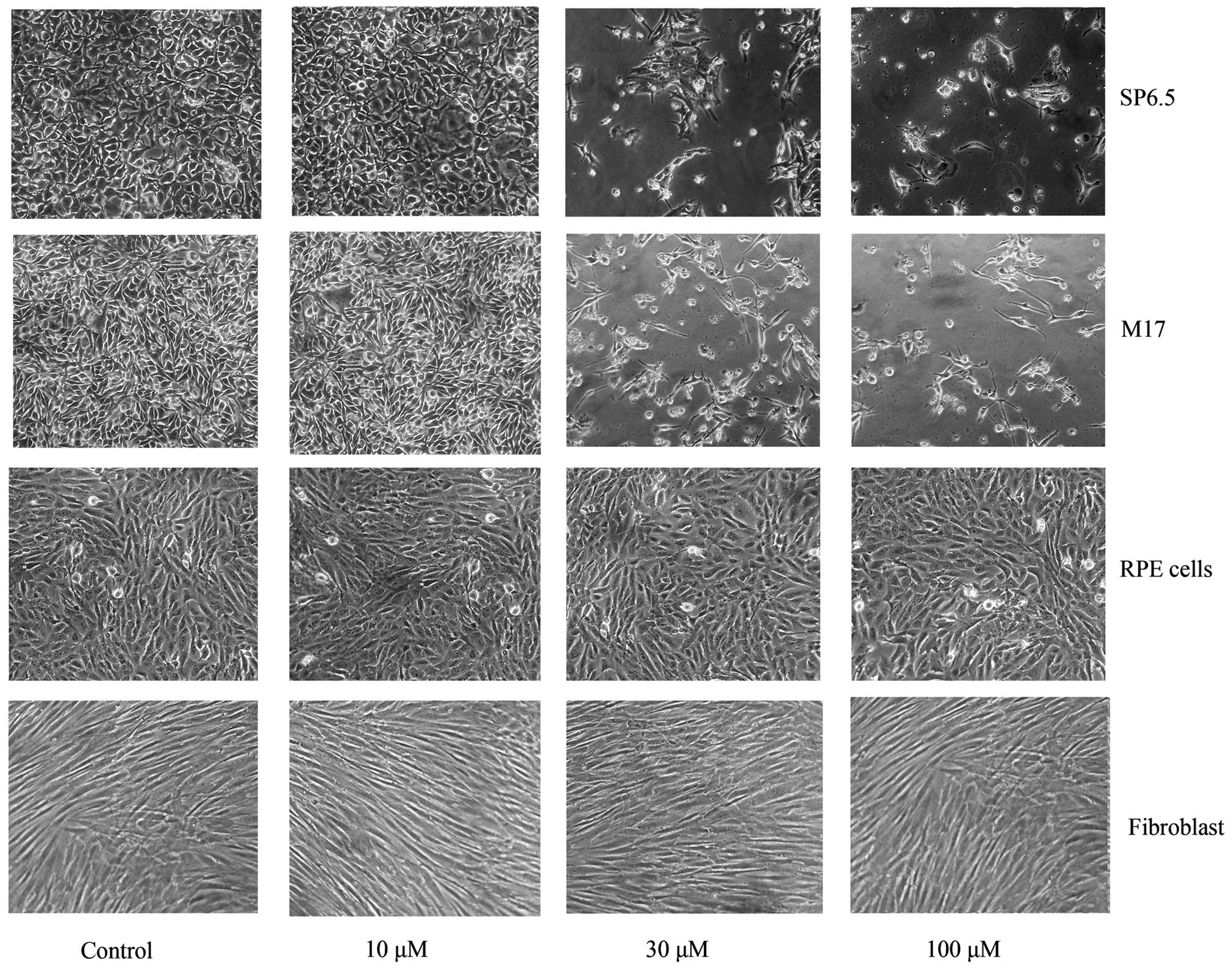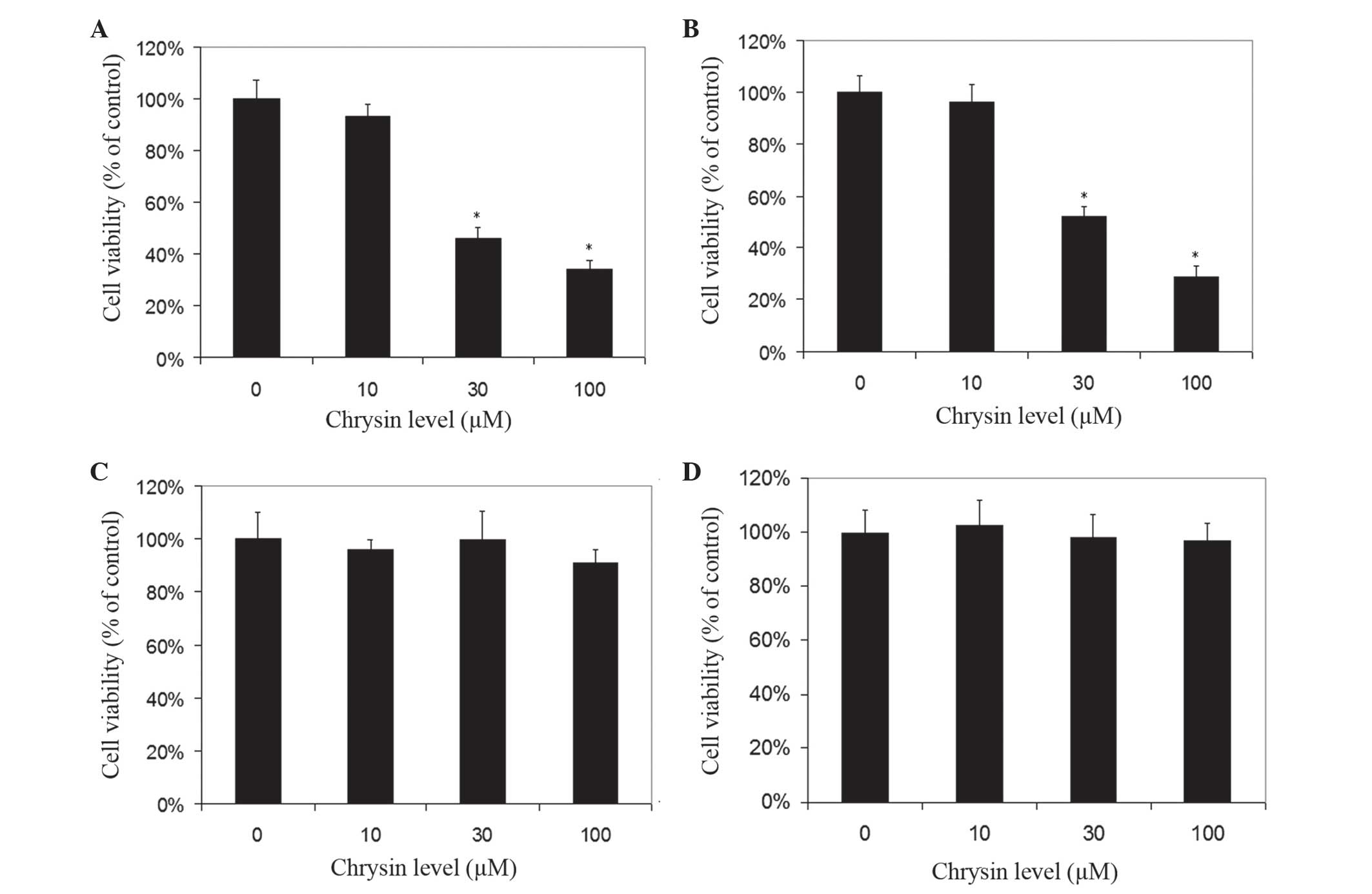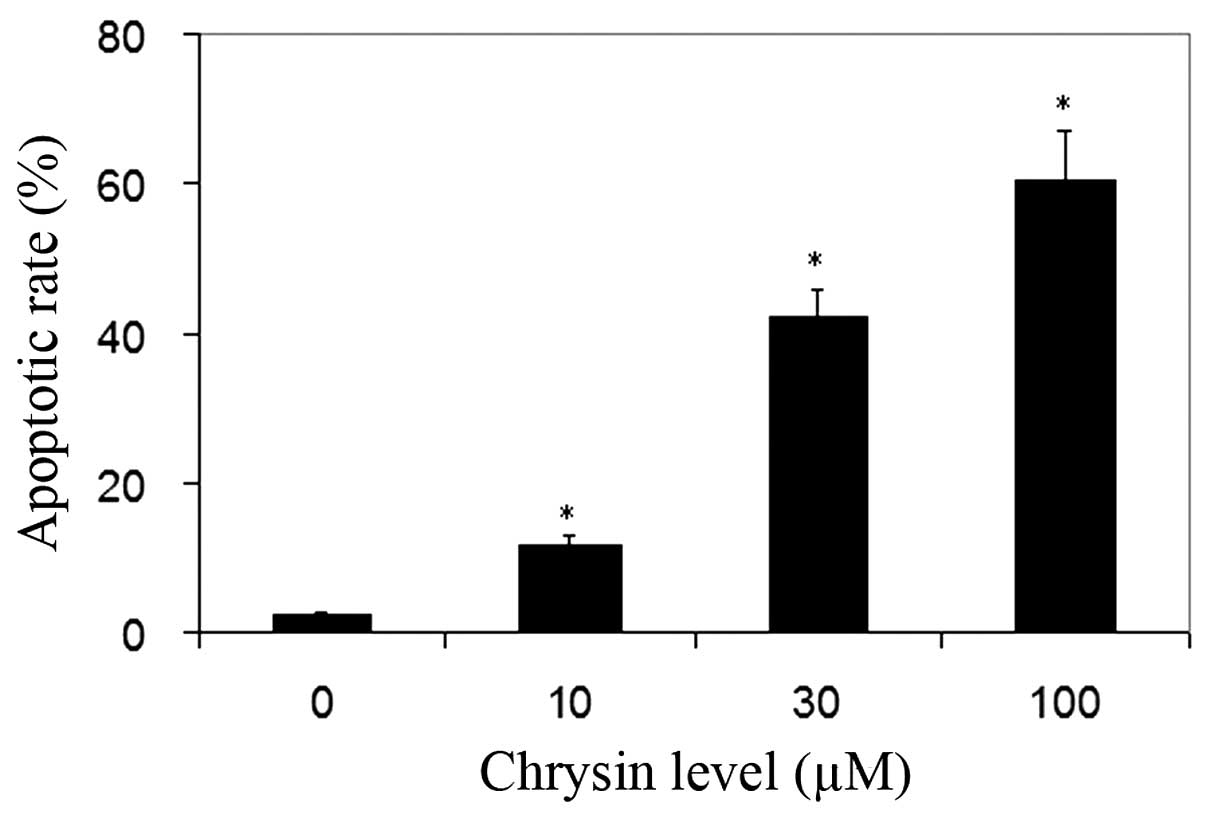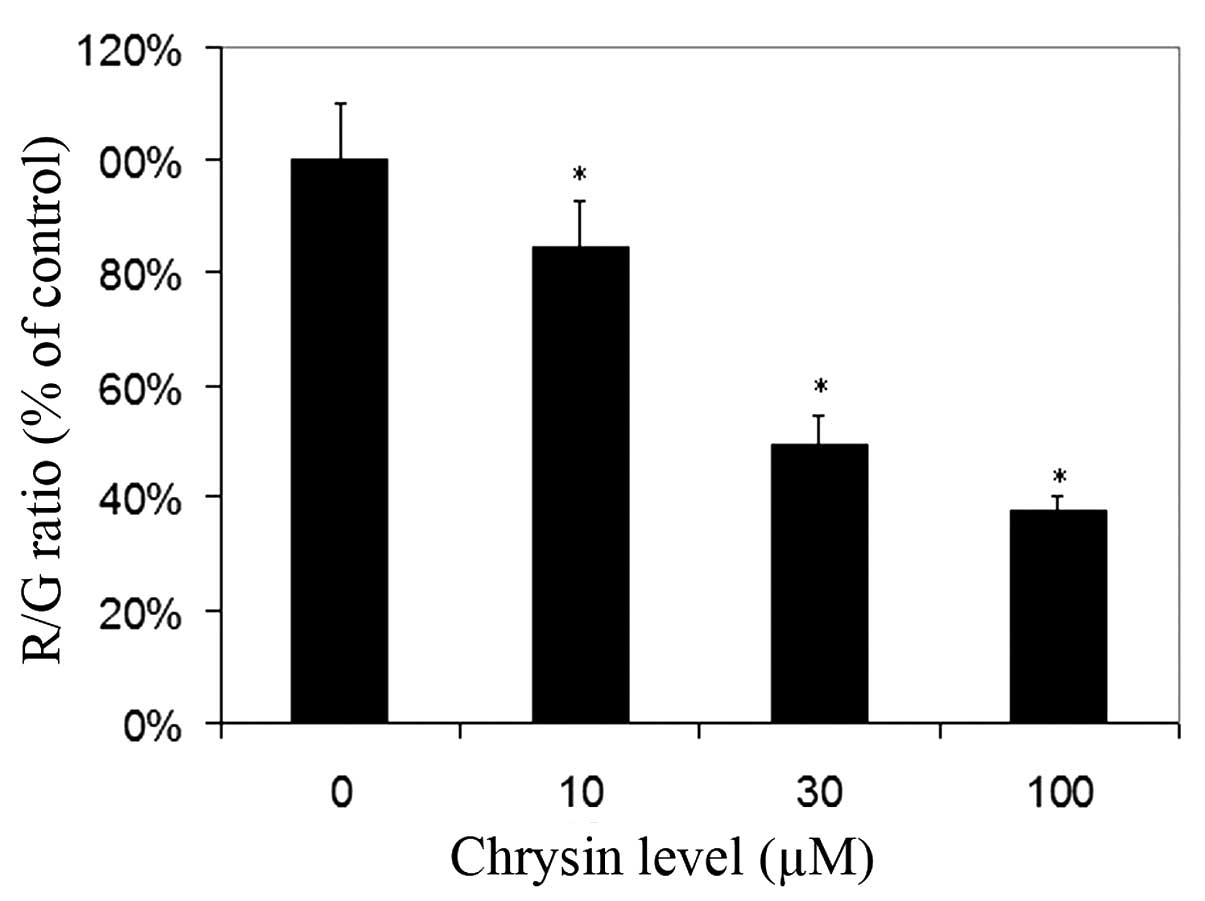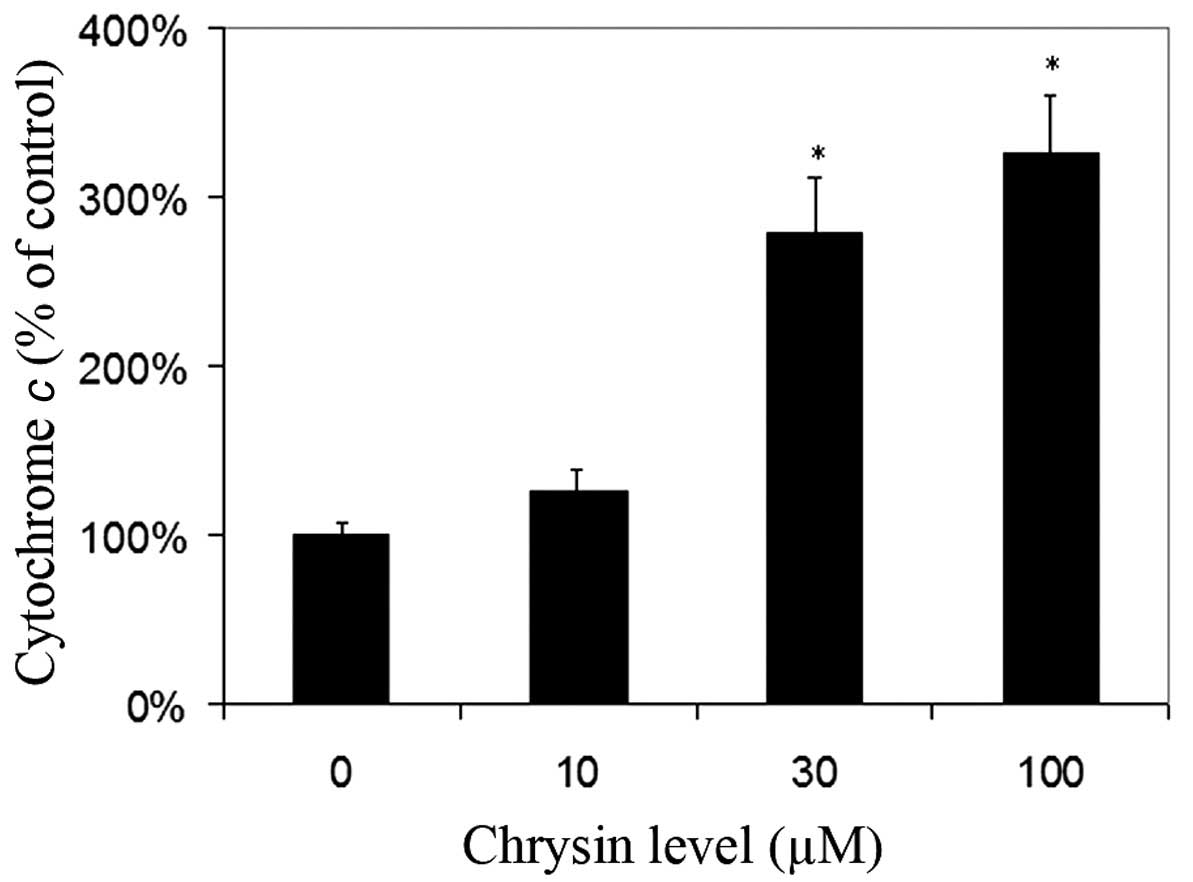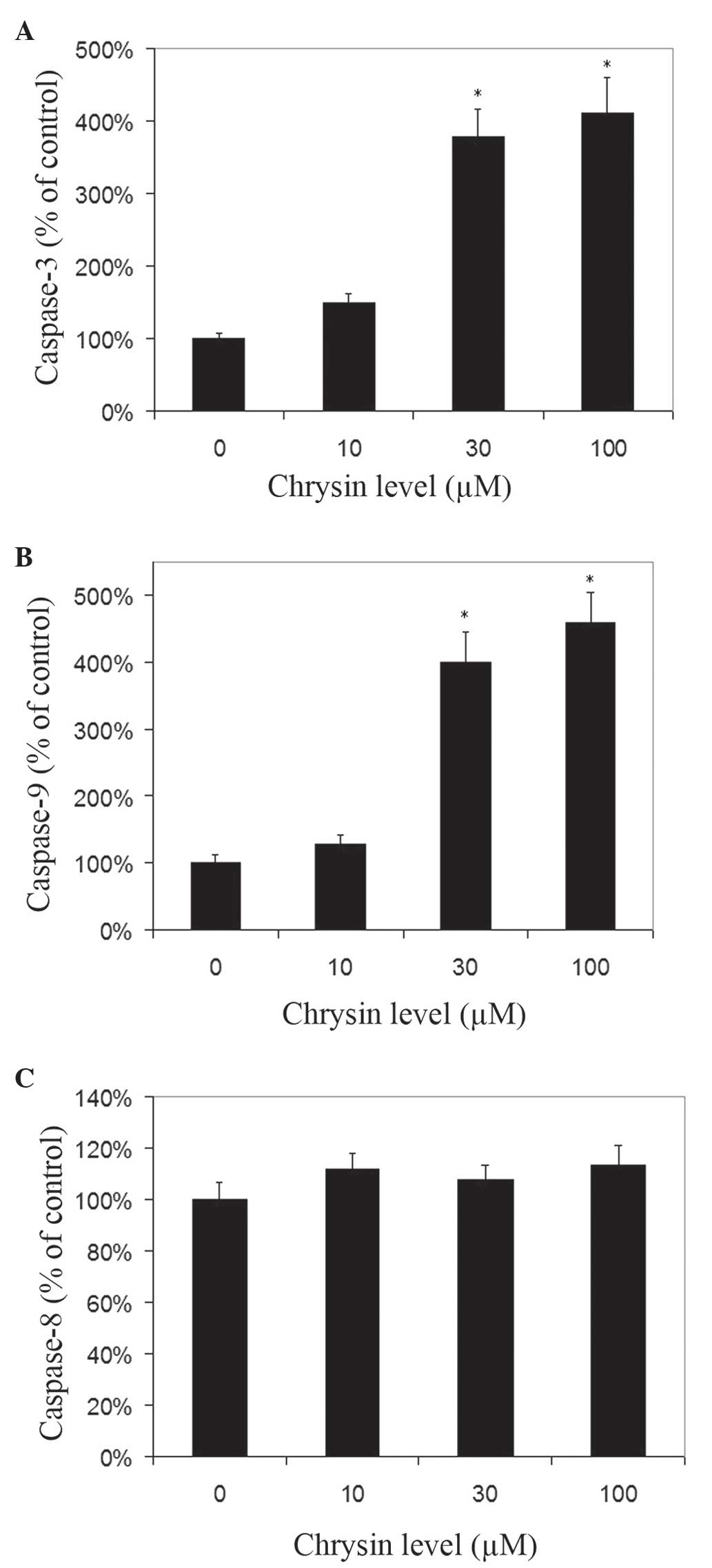|
1
|
Hu DN, Yu GP, McCormick SA, Schneider S
and Finger PT: Population-based incidence of uveal melanoma in
various races and ethnic groups. Am J Ophthalmol. 140:612–617.
2005. View Article : Google Scholar : PubMed/NCBI
|
|
2
|
Kujala E, Mäkitie T and Kivelä T: Very
long-term prognosis of patients with malignant uveal melanoma.
Invest Ophthalmol Vis Sci. 44:4651–4659. 2003. View Article : Google Scholar : PubMed/NCBI
|
|
3
|
Augsburger JJ, Corrêa ZM and Shaikh AH:
Effectiveness of treatments for metastatic uveal melanoma. Am J
Ophthalmol. 148:119–127. 2009. View Article : Google Scholar : PubMed/NCBI
|
|
4
|
Monasterio A, Urdaci MC, Pinchuk IV,
López-Moratalla N and Martínez-Irujo JJ: Flavonoids induce
apoptosis in human leukemia U937 cells through caspase- and
caspase-calpain-dependent pathways. Nutr Cancer. 50:90–100. 2004.
View Article : Google Scholar : PubMed/NCBI
|
|
5
|
Samarghandian S, Afshari JT and Davoodi S:
Chrysin reduces proliferation and induces apoptosis in the human
prostate cancer cell line pc-3. Clinics (Sao Paulo). 66:1073–1079.
2011. View Article : Google Scholar : PubMed/NCBI
|
|
6
|
Cho H, Yun CW, Park WK, Kong JY, Kim KS,
Park Y, Lee S and Kim BK: Modulation of the activity of
pro-inflammatory enzymes, COX-2 and iNOS, by chrysin derivatives.
Pharmacol Res. 49:37–43. 2004. View Article : Google Scholar : PubMed/NCBI
|
|
7
|
Woodman OL and Chan ECh: Vascular and
anti-oxidant actions of flavonols and flavones. Clin Exp Pharmacol
Physiol. 31:786–790. 2004. View Article : Google Scholar : PubMed/NCBI
|
|
8
|
Khoo BY, Chua SL and Balaram P: Apoptotic
effects of chrysin in human cancer cell lines. Int J Mol Sci.
11:2188–2199. 2010. View Article : Google Scholar : PubMed/NCBI
|
|
9
|
Pichichero E, Cicconi R, Mattei M and
Canini A: Chrysin-induced apoptosis is mediated through p38 and Bax
activation in B16-F1 and A375 melanoma cells. Int J Oncol.
38:473–483. 2011.PubMed/NCBI
|
|
10
|
Pichichero E, Cicconi R, Mattei M, Muzi MG
and Canini A: Acacia honey and chrysin reduce proliferation of
melanoma cells through alterations in cell cycle progression. Int J
Oncol. 37:973–981. 2010.PubMed/NCBI
|
|
11
|
Yang B, Huang J, Xiang T, Yin X, Luo X,
Huang J, Luo F, Li H, Li H and Ren G: Chrysin inhibits metastatic
potential of human triple-negative breast cancer cells by
modulating matrix metalloproteinase-10, epithelial to mesenchymal
transition, and PI3K/Akt signaling pathway. J Appl Toxicol.
34:105–112. 2014. View
Article : Google Scholar : PubMed/NCBI
|
|
12
|
Samarghandian S, Nezhad MA and Mohammadi
G: Role of caspases, Bax and Bcl-2 in chrysin-induced apoptosis in
the A549 human lung adenocarcinoma epithelial cells. Anticancer
Agents Med Chem. 14:901–909. 2014. View Article : Google Scholar : PubMed/NCBI
|
|
13
|
Lee SJ, Yoon JH and Song KS: Chrysin
inhibited stem cell factor (SCF)/c-Kit complex-induced cell
proliferation in human myeloid leukemia cells. Biochem Pharmacol.
74:215–225. 2007. View Article : Google Scholar : PubMed/NCBI
|
|
14
|
Sak K: Cytotoxicity of dietary flavonoids
on different human cancer types. Pharmacogn Rev. 8:122–146. 2014.
View Article : Google Scholar : PubMed/NCBI
|
|
15
|
Yu XM, Phan T, Patel PN, Jaskula-Sztul R
and Chen H: Chrysin activates Notch1 signaling and suppresses tumor
growth of anaplastic thyroid carcinoma in vitro and in vivo.
Cancer. 119:774–781. 2013. View Article : Google Scholar : PubMed/NCBI
|
|
16
|
Shao JJ, Zhang AP, Qin W, Zheng L, Zhu YF
and Chen X: AMP-activated protein kinase (AMPK) activation is
involved in chrysin-induced growth inhibition and apoptosis in
cultured A549 lung cancer cells. Biochem Biophys Res Commun.
423:448–453. 2012. View Article : Google Scholar : PubMed/NCBI
|
|
17
|
Phan T, Yu XM, Kunnimalaiyaan M and Chen
H: Antiproliferative effect of chrysin on anaplastic thyroid
cancer. J Surg Res. 170:84–88. 2011. View Article : Google Scholar : PubMed/NCBI
|
|
18
|
Pilátová M, Stupáková V, Varinská L,
Sarisský M, Mirossay L, Mirossay A, Gál P, Kraus V, Dianisková K
and Mojzis J: Effect of selected flavones on cancer and endothelial
cells. Gen Physiol Biophys. 29:134–143. 2010. View Article : Google Scholar : PubMed/NCBI
|
|
19
|
Hong TB, Rahumatullah A, Yogarajah T,
Ahmad M and Yin KB: Potential effects of chrysin on MDA-MB-231
cells. Int J Mol Sci. 11:1057–1069. 2010. View Article : Google Scholar : PubMed/NCBI
|
|
20
|
Weng MS, Ho YS and Lin JK: Chrysin induces
G1 phase cell cycle arrest in C6 glioma cells through inducing
p21Waf1/Cip1 expression: Involvement of p38 mitogen-activated
protein kinase. Biochem Pharmacol. 69:1815–1827. 2005. View Article : Google Scholar : PubMed/NCBI
|
|
21
|
Woo KJ, Jeong YJ, Park JW and Kwon TK:
Chrysin-induced apoptosis is mediated through caspase activation
and Akt inactivation in U937 leukemia cells. Biochem Biophys Res
Commun. 325:1215–1222. 2004. View Article : Google Scholar : PubMed/NCBI
|
|
22
|
Zhang T, Chen X, Qu L, Wu J, Cui R and
Zhao Y: Chrysin and its phosphate ester inhibit cell proliferation
and induce apoptosis in Hela cells. Bioorg Med Chem. 12:6097–6105.
2004. View Article : Google Scholar : PubMed/NCBI
|
|
23
|
Hu DN, McCormick SA, Ritch R and
Pelton-Henrion K: Studies of human uveal melanocytes in vitro:
Isolation, purification and cultivation of human uveal melanocytes.
Invest Ophthalmol Vis Sci. 34:2210–2219. 1993.PubMed/NCBI
|
|
24
|
Soulieres D, Rousseau A, Deschenes J,
Tremblay M, Tardif M and Pelletier G: Characterization of
gangliosides in human uveal melanoma cells. Int J Cancer.
49:498–503. 1991. View Article : Google Scholar : PubMed/NCBI
|
|
25
|
Lu C, Song E, Hu DN, Chen M, Xue C, Rosen
R and McCormick SA: Curcumin induces cell death in human uveal
melanoma cells through mitochondrial pathway. Curr Eye Res.
35:352–360. 2010. View Article : Google Scholar : PubMed/NCBI
|
|
26
|
Parthasarathy G and Philipp MT: The
MEK/ERK pathway is the primary conduit for Borrelia
burgdorferi-induced inflammation and P53-mediated apoptosis in
oligodendrocytes. Apoptosis. 19:76–89. 2014. View Article : Google Scholar : PubMed/NCBI
|
|
27
|
Turgeman T, Kakongi N, Schneider A,
Vinokur Y, Teper-Bamnolker P, Carmeli S, Levy M, Skory CD, Lichter
A and Eshel D: Induction of Rhizopus oryzae germination under
starvation using host metabolites increases spore susceptibility to
heat stress. Phytopathology. 104:240–247. 2014. View Article : Google Scholar : PubMed/NCBI
|
|
28
|
Cossarizza A, Baccarani-Contri M,
Kalashnikova G and Franceschi C: A new method for the
cytofluorimetric analysis of mitochondrial membrane potential using
the J-aggregate forming lipophilic cation
5,5′,6,6′-tetrachloro-1,1′,3,3′-tetraethylbenzimidazolcarbocyanine
iodide (JC-1). Biochem Biophys Res Commun. 197:40–45. 1993.
View Article : Google Scholar : PubMed/NCBI
|
|
29
|
Gilchrest BA, Eller MS, Geller AC and Yaar
M: The pathogenesis of melanoma induced by ultraviolet radiation. N
Engl J Med. 340:1341–1348. 1999. View Article : Google Scholar : PubMed/NCBI
|
|
30
|
Bergman L, Seregard S, Nilsson B, Ringborg
U, Lundell G and Ragnarsson-Olding B: Incidence of uveal melanoma
in Sweden from 1960 to 1998. Invest Ophthalmol Vis Sci.
43:2579–2583. 2002.PubMed/NCBI
|
|
31
|
Yu GP, Hu DN and McCormick SA: Latitude
and incidence of ocular melanoma. Photochem Photobiol.
82:1621–1626. 2006. View Article : Google Scholar : PubMed/NCBI
|
|
32
|
Spendlove HE, Damato BE, Humphreys J,
Barker KT, Hiscott PS and Houlston RS: BRAF mutations are
detectable in conjunctival but not uveal melanomas. Melanoma Res.
14:449–452. 2004. View Article : Google Scholar : PubMed/NCBI
|
|
33
|
Vajdic CM, Hutchins AM, Kricker A, Aitken
JF, Armstrong BK, Hayward NK and Armes JE: Chromosomal gains and
losses in ocular melanoma detected by comparative genomic
hybridization in an Australian population-based study. Cancer Genet
Cytogenet. 144:12–17. 2003. View Article : Google Scholar : PubMed/NCBI
|
|
34
|
Hu DN, Yu G, McCormick SA and Finger PT:
Population-based incidence of conjunctival melanoma in various
races and ethnic groups and comparison with other melanomas. Am J
Ophthalmol. 145:418–423. 2008. View Article : Google Scholar : PubMed/NCBI
|
|
35
|
McConkey DJ: Biochemical determinants of
apoptosis and necrosis. Toxicol Lett. 99:157–168. 1998. View Article : Google Scholar : PubMed/NCBI
|
|
36
|
Kroemer G, Dallaporta B and Resche-Rigon
M: The mitochondrial death/life regulator in apoptosis and
necrosis. Annu Rev Physiol. 60:619–642. 1998. View Article : Google Scholar : PubMed/NCBI
|
|
37
|
Chen X, Wang J, Shen H, Lu J, Li C, Hu DN,
Dong XD, Yan D and Tu L: Epigenetics, microRNAs, and
carcinogenesis: Functional role of microRNA-137 in uveal melanoma.
Invest Ophthalmol Vis Sci. 52:1193–1199. 2011. View Article : Google Scholar : PubMed/NCBI
|
















